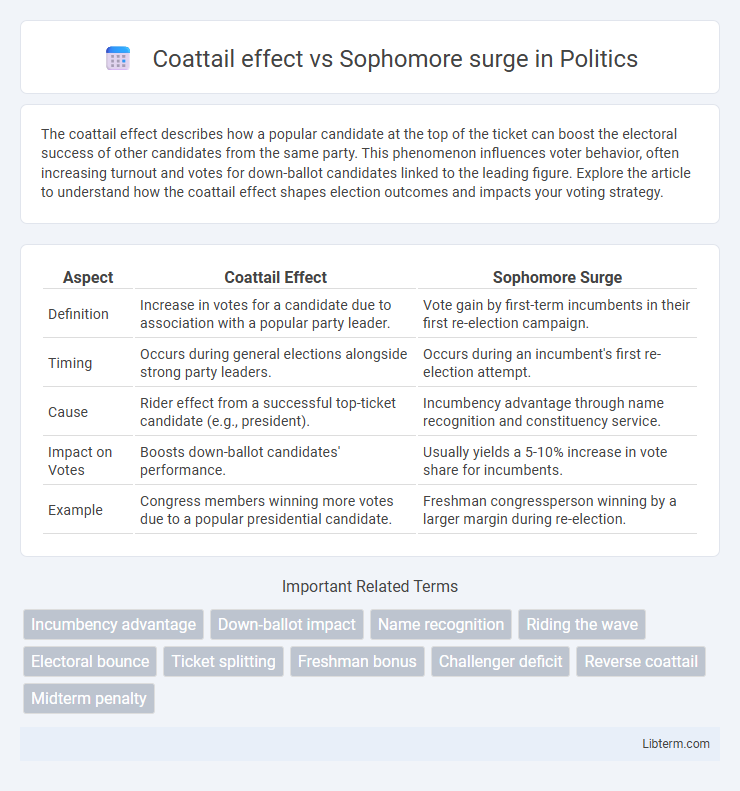The coattail effect describes how a popular candidate at the top of the ticket can boost the electoral success of other candidates from the same party. This phenomenon influences voter behavior, often increasing turnout and votes for down-ballot candidates linked to the leading figure. Explore the article to understand how the coattail effect shapes election outcomes and impacts your voting strategy.
Table of Comparison
| Aspect | Coattail Effect | Sophomore Surge |
|---|---|---|
| Definition | Increase in votes for a candidate due to association with a popular party leader. | Vote gain by first-term incumbents in their first re-election campaign. |
| Timing | Occurs during general elections alongside strong party leaders. | Occurs during an incumbent's first re-election attempt. |
| Cause | Rider effect from a successful top-ticket candidate (e.g., president). | Incumbency advantage through name recognition and constituency service. |
| Impact on Votes | Boosts down-ballot candidates' performance. | Usually yields a 5-10% increase in vote share for incumbents. |
| Example | Congress members winning more votes due to a popular presidential candidate. | Freshman congressperson winning by a larger margin during re-election. |
Understanding the Coattail Effect
The Coattail Effect occurs when a popular candidate at the top of the ticket, such as a presidential nominee, boosts the electoral chances of other candidates from the same party in down-ballot races. This phenomenon relies heavily on voter alignment and party loyalty, influencing voter turnout and candidate support across multiple races. Understanding the Coattail Effect is essential for analyzing election dynamics, as it highlights how top-tier candidates can impact broader party success beyond their individual campaigns.
Defining the Sophomore Surge
The Sophomore Surge refers to the significant increase in votes typically received by first-term congressional candidates when they run for re-election, often attributed to greater name recognition and constituent services. Unlike the Coattail Effect, which describes the boost candidates gain from a popular party leader during elections, the Sophomore Surge is a personalized advantage for incumbents. Studies show that sophomore candidates can see an average vote percentage increase of 5-10% compared to their initial election, highlighting the importance of incumbency in electoral success.
Origins and Historical Context
The Coattail effect originates from early 20th-century U.S. elections, describing a popular candidate's ability to boost votes for other party members down the ballot. The Sophomore surge emerged prominently in political science research during the 1970s, highlighting the significant vote increase incumbents experience when seeking their first reelection. Both phenomena reflect evolving voter behaviors rooted in party loyalty and name recognition within historical electoral contexts.
Key Differences Between Coattail Effect and Sophomore Surge
The coattail effect occurs when a popular candidate at the top of the ticket boosts the electoral performance of party members in down-ballot races, whereas the sophomore surge refers to the significant increase in votes that a first-term incumbent typically experiences in their first reelection campaign. Key differences include the coattail effect being dependent on the influence of a high-profile candidate during an election cycle, while the sophomore surge is intrinsic to the incumbent's growing name recognition and constituent services. The coattail effect primarily benefits party candidates across multiple races simultaneously, while the sophomore surge focuses exclusively on the success of an individual candidate in their immediate reelection bid.
Impact on Election Outcomes
The Coattail effect significantly boosts down-ballot candidates from a popular incumbent's party during high-profile elections, influencing voter turnout and party success rates. The Sophomore surge reflects a notable increase in vote share for first-term incumbents seeking reelection, often attributed to greater name recognition and constituent services. Both phenomena shape election outcomes by altering vote distributions, with the Coattail effect benefiting multiple candidates simultaneously and the Sophomore surge enhancing individual incumbents' reelection prospects.
Factors Influencing Coattail Effect
The coattail effect is influenced by factors such as the popularity and approval ratings of the top-ticket candidate, the level of party unity, and the intensity of the election campaign. Strong presidential candidates can boost down-ballot races by increasing voter turnout and party loyalty, while alignment with national party platforms also plays a crucial role. Regional political climate and media coverage further affect how effectively the coattail effect translates into votes for lesser-known candidates.
Drivers Behind the Sophomore Surge
The Sophomore Surge is primarily driven by increased name recognition and constituent service efforts from first-term incumbents, enhancing voter support in subsequent elections. Effective campaign strategies and greater access to party resources also contribute significantly to this surge. Unlike the Coattail effect, which depends on the popularity of higher-ticket candidates, the Sophomore Surge reflects the incumbent's own electoral strengths and growing personal voter base.
Notable Examples in Political History
The coattail effect is exemplified by Ronald Reagan's 1980 presidential win, which boosted Republican congressional candidates. The sophomore surge is prominently seen in Barack Obama's 2008 and 2010 House members who strengthened their positions after initial election victories. Both phenomena highlight strategic voter behavior changes during key electoral cycles in U.S. history.
Implications for Political Parties and Candidates
The coattail effect boosts lesser-known candidates by linking their success to a popular party leader, enhancing party unity and vote shares during elections. Sophomore surge reflects increased electoral support for first-term incumbents due to name recognition and constituency services, strengthening individual candidate profiles and party stability. Both phenomena influence campaign strategies, resource allocation, and candidate recruitment by shaping voter behavior and electoral dynamics.
Future Trends and Research Directions
Emerging research on the coattail effect and sophomore surge highlights an increasing emphasis on voter behavior analytics and machine learning techniques to predict electoral outcomes. Future trends include integrating social media data to understand candidate influence and the impact of incumbency on election dynamics more precisely. Scholars are also exploring cross-cultural comparisons to refine theoretical models and assess how digital campaign strategies modulate these political phenomena.
Coattail effect Infographic

 libterm.com
libterm.com